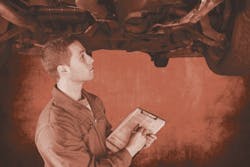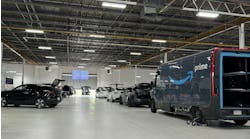Collision repair is all about safety—ensuring that customers are sent home with vehicles that have the same crash-worthiness as when they were new. What some repairers don’t know, however, is the impact that their work can have on modern vehicle safety systems, even on the most basic of jobs.
Many technicians are quick to reinstall vehicle components without any thought about the effect on other systems, says Will Latuff of Latuff Brothers Auto Body in St. Paul, Minn.
They don’t know that incorrect methods may cause vehicle safety systems, such as airbags, to function improperly in a future crash.
“There is no such thing as a straightforward repair anymore. Vehicle safety systems are interconnected more than people think, and repairers must understand the relationship between repair processes and safety system performance,” Latuff says. “Even simple things like PDR work can have safety system implications. You have to be rigid about assessing procedures that affect safety components because assumptions open you up to costly mistakes.”
Mistakes are common, says Billy Walkowiak, owner of Belmont, N.C.–based Collision Safety Consultants, a firm that conducts post-collision repair inspections. He says eight out of every 10 cars inspected have safety-related problems, and roughly half of them have errors with safety system components.
“It’s absolutely a problem. I’m finding more and more of those problems every day,” Walkowiak says, problems that can lead to significant legal issues for shops.
No Excuses
Parese says responsibility for repair quality ultimately falls on repair shops when it comes to the law. You have to put forth your due diligence because there are a couple of defenses that just won’t fly in the courtroom:
“The insurer wouldn’t pay for it.” There are times when an extra step in the repair process is necessary, and occasionally, insurers won’t pay for the effort. But if the shop elects to skip the step, they can’t put the blame on the instructions of the insurance company, Parese says. The majority of DRP contracts specifically indemnify and hold insurance carriers harmless.
“I didn’t know.” Most technicians wouldn’t intentionally make a mistake that negatively impacts a safety component. It’s often caused by lack of information and training. But ignorance is never a successful defense in court.
“You’ll lose the case every time if you say you just didn’t know something,” Parese says. “You’re responsible for the vehicle when it leaves your shop. You have liability over everything that you’ve touched or affected.”
Professional Negligence
Neglecting to ensure performance in every safety component during vehicle repairs can be bad news for repairer facilities.
If the problem causes a subsequent crash or results in occupant injury, shops—and in some cases technicians—can be held liable for professional negligence and personal injury, says John Parese, attorney with New Haven, Conn.–based law firm Buckley & Wynn, and general counsel for the Auto Body Association of Connecticut.
“If you disrupt the timing of an airbag because of a repair you performed, and you neglected to follow OEM specifications in the process, you undoubtedly can expose yourself to liability and can get sued,” Parese says.
Parese says auto body technicians should uphold a certain “standard of care.”
Generally speaking, they should demonstrate that they did everything possible to ensure that all vehicle systems work properly prior to delivery, Parese says.
Courts identify whether guidelines exist that outline what should have been done in a particular circumstance, whether technicians referred to the information, and whether technicians are up to date with modern technology, processes and procedures.
Although every case is different, the damages for negligence claims can be significant if technicians can’t prove that “standard of care.” Courts look at several types of compensation such as medical bills, loss of wages, pain and suffering, loss of enjoyment of life activities, and permanent disability.
“It only takes one instance to dramatically hurt your business,” Parese says. “The amount of those damages could put you out of business.”
Safety Triggers
Latuff says the number of safety modules in vehicles increases every year. It’s common to see about a dozen computer modules in new vehicles, and up to 30 in high-end cars. It’s a lot, he says, and technicians are responsible for proper performance of each one. It’s essential to put forth effort to research, perform and document all necessary repairs, Latuff says.
With so many safety components, how do you know when something might be affected? Latuff developed a series of five safety triggers that prompt a “go see” event, requiring technicians to look up the procedures.
1. Restraint system components. Technicians automatically look up procedures any time they deal with a restraint system. They assess torque specifications and guidelines for the reuse of components.
2. Wheel alignments. Latuff says all vehicles today have electronic stability control, steering angle sensors and electronic power steering. Each piece must be recalibrated after alignment using a different method.
3. Front seats. Safety procedures should be assessed any time you repair or replace the front seats of a vehicle, Latuff says.
The passenger seat is the most sensitive because it includes the occupant classification system, which controls whether to deploy the airbag and to what level. Each OEM has various positions regarding when that system should be checked and recalibrated.
Latuff says that procedure requires use of scan tools to complete. Possessing necessary scan tools allows repairers to acquire snap shots of vehicles before and after the repair to identify whether it had any effect on the safety module.
4. Pillar trim. Procedures must be assessed any time you remove A, B, C or D pillar trim, Latuff says. Know whether those pieces can be reused, and whether certain clips are needed to ensure proper performance of a side curtain airbag, if there is one.
5. Suspension. Procedures must be assessed during replacement or repair of all suspension components, Latuff says. Those components tie into the performance of stability control systems, steering angle sensors and tire-pressure-monitoring systems. Those components are all interconnected, so an error in one causes an error in all of them.
“To do this, shops need access to OEM information. Research is key,” Latuff says. “You have to learn to speak the language of each manufacturer, learn their terms for safety systems, and learn what resources to use. Once you set that habit in place, that’s how you achieve the best and safest repair.”



